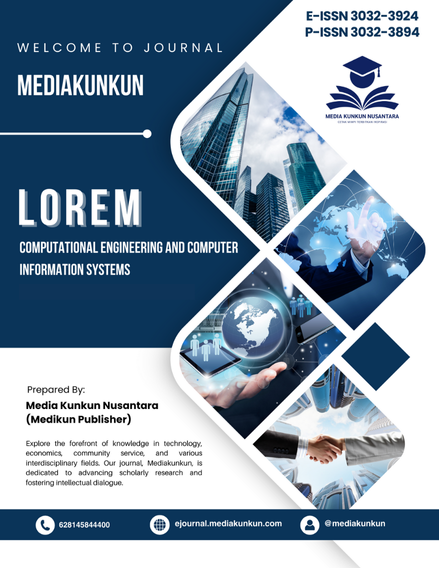The Role of Information Technology in Enhancing Operational Efficiency and Driving Digital Transformation in Manufacturing
Main Article Content
Abstract
Digital transformation has become essential for the manufacturing industry, driving innovation and the adoption of information technology (IT) to improve efficiency and competitiveness. This study presents a literature review on IT applications in manufacturing, focusing on key technologies such as Enterprise Resource Planning (ERP), cloud computing, the Internet of Things (IoT), Artificial Intelligence (AI), and manufacturing information systems (MIS). Findings show that IT enables process automation, real-time monitoring, data integration, and informed decision-making. The adoption of ERP, IoT, AI, and cloud computing optimizes supply chains, reduces lead times, lowers operational costs, and enhances product quality. Integrated systems and clear standard operating procedures (SOPs) are vital for addressing delivery delays and improving interdepartmental coordination. However, challenges remain, including limited infrastructure, the need for continuous workforce training, and complex system integration. A shortage of skilled talent, particularly in IoT development, is a significant barrier. A collaborative strategy involving government, industry, and educational institutions is crucial to maximize IT’s benefits and ensure sustainable competitiveness in the digital era.
Downloads
Article Details
How to Cite
References
Ravelinda, Ramadhan, and Iswanto, “Pengaruh Penerapan Teknologi Informasi terhadap Efisiensi Operasional Perusahaan Manufaktur,” Jurnal Teknologi dan Manajemen Industri, vol. 9, no. 1, pp. 45–58, 2023.
N. Allo, Naim, Soleh, Lazinu, and Nurkim, “Peran Teknologi Cloud Computing dalam Transformasi Infrastruktur TI Perusahaan di Industri Manufaktur,” Jurnal Sistem Informasi & Teknologi, vol. 10, no. 2, pp. 77–91, 2023.
B. N. Yahya, “Sistem Informasi Manufaktur dalam Kerangka Kerja Sistem Informasi Manajemen,” Jurnal Ilmiah Sistem Informasi, vol. 8, no. 4, pp. 120–134, 2022.
Mauluddin, Kurniadi, and Abdullah, “Perencanaan Sistem Informasi Manufaktur Berbasis Engineering to Order dan Make to Order,” Jurnal Riset Teknologi Industri, vol. 7, no. 3, pp. 105–118, 2021.
A. Taufiq, “Rancangan Sistem Informasi Manufaktur Terintegrasi untuk Mempercepat Waktu Pengiriman Produk (Studi Kasus PT BBI),” Jurnal Teknologi Informasi & Rekayasa Sistem, vol. 12, no. 1, pp. 60–75, 2023.
Anggriani and Firdaus, “Penerapan Strategi Transformasi Digital Manufaktur pada Sistem Lingkungan Informasi Manajemen,” Jurnal Sistem Informasi dan Inovasi, vol. 6, no. 2, pp. 88–101, 2022.
Mutaqqin, Wibawa, and Nabila, “Inovasi Digital untuk Masyarakat yang Lebih Cerdas 5.0: Analisis Tren Teknologi Informasi dan Prospek Masa Depan,” Jurnal Teknologi Masa Depan, vol. 11, no. 1, pp. 33–47, 2023.
Danu, Mawasandi, Aziz, Rosyadi, and Wahyudi, “Transformasi Manajemen Rantai Pasokan Berbasis Internet of Things (IoT): Tinjauan Literatur,” Jurnal Logistik dan Supply Chain, vol. 5, no. 2, pp. 54–68, 2022.
Sumarsih, Permatasari, and Amyati, “Transformasi Manufaktur di Era Industri 4.0: Peran Teknologi Cerdas, Ekonomi Sirkular, dan Pengembangan SDM,” Jurnal Revolusi Industri dan Keberlanjutan, vol. 13, no. 1, pp. 40–58, 2024.
Rifai, Rachmat, and Prasetyo, “Pemanfaatan IoT untuk Rancang Bangun UAV Pengukuran Polutan CO dan CO₂ di Pabrik Manufaktur Menggunakan ESP-NOW,” Jurnal Otomasi dan Lingkungan, vol. 7, no. 4, pp. 95–108, 2023.
Anaam, Hidayat, Pranata, Abdillah, and Putra, “Pengaruh Tren Otomasi dalam Dunia Manufaktur dan Industri,” Jurnal Inovasi Industri, vol. 9, no. 3, pp. 123–136, 2023.
I. Lubis, “Pengembangan Teknologi Mesin Otomatis untuk Peningkatan Produktivitas dalam Industri Manufaktur,” Jurnal Inovasi Teknologi Manufaktur, vol. 8, no. 2, pp. 59–73, 2024.
R. Azwina, “Strategi Industri Manufaktur dalam Meningkatkan Percepatan Pertumbuhan Ekonomi di Indonesia,” Jurnal Ekonomi & Kebijakan Publik, vol. 10, no. 1, pp. 82–96, 2023.
Kristiyawan and Wardoyo, “Review Artikel: Pengaplikasian Internet of Things (IoT) dalam Manufaktur Industri Farmasi di Era Industri 4.0,” Jurnal Inovasi Teknik dan Edukasi Teknologi, vol. 6, no. 2, pp. 70–85, 2024.
A. Puspitasari, “Dampak Integrasi Sistem Informasi terhadap Efisiensi Rantai Pasok pada Industri Manufaktur di Indonesia,” Jurnal Manajemen Teknologi, vol. 15, no. 1, pp. 45–58, 2022.
B. Santoso and R. A. Wibowo, “Peran Adopsi Teknologi Informasi dalam Peningkatan Produktivitas dan Daya Saing Industri Manufaktur Nasional,” Jurnal Teknik Industri, vol. 20, no. 2, pp. 112–125, 2023.
B. Kurniawan, “Manfaat Cloud Computing dalam Peningkatan Efisiensi Biaya dan Kolaborasi pada UMKM di Indonesia,” Jurnal Teknologi Informasi, vol. 10, no. 1, pp. 78–90, 2022.
D. Setiawan and A. Putri, “Analisis Dampak Implementasi ERP terhadap Efisiensi Pengelolaan Inventaris dan Perencanaan Produksi pada Industri Manufaktur di Indonesia,” Jurnal Sistem Informasi Bisnis, vol. 13, no. 2, pp. 165–178, 2023.
R. Pratama and S. Lestari, “Pengaruh Implementasi Cloud Computing terhadap Skalabilitas Bisnis pada UMKM di Indonesia,” Jurnal Bisnis dan Manajemen, vol. 17, no. 1, pp. 89–102, 2023.
D. Wijaya, “Analisis Pengurangan Biaya Operasional melalui Adopsi Cloud Computing di Perusahaan Indonesia,” Jurnal Teknologi Informasi dan Komunikasi, vol. 11, no. 2, pp. 145–158, 2022.
H. Susanto, “Transformasi Digital UMKM di Indonesia: Peran Peningkatan Penetrasi Internet,” Jurnal Ekonomi Bisnis, vol. 25, no. 1, pp. 45–58, 2022.
T. Wijaya and R. Lestari, “Dampak Adopsi Teknologi Informasi terhadap Aksesibilitas dan Interaktivitas Pembelajaran di Sektor Pendidikan Indonesia,” Jurnal Pendidikan Teknologi Informasi, vol. 7, no. 2, pp. 112–125, 2023.
R. Lestari and H. Santoso, “Dampak Implementasi Internet of Things terhadap Efisiensi Logistik di Indonesia,” Jurnal Logistik Indonesia, vol. 8, no. 1, pp. 56–70, 2023.
D. Wijaya and A. Saputro, “Analisis Tantangan Adopsi Internet of Things di Industri Manufaktur Indonesia,” Jurnal Teknologi Industri, vol. 15, no. 2, pp. 112–125, 2024.
A. Putra and D. P. Sari, “Pengaruh Sistem Informasi Terintegrasi terhadap Kecepatan Pengambilan Keputusan pada Perusahaan Manufaktur,” Jurnal Manajemen Sistem Informasi, vol. 12, no. 1, pp. 78–90, 2023.
E. Suryani and B. Nugroho, “Dampak Implementasi Sistem Informasi Terintegrasi terhadap Efisiensi Produksi dan Akurasi Inventaris di Industri Manufaktur Indonesia,” Jurnal Teknologi Industri, vol. 16, no. 2, pp. 112–125, 2024.

